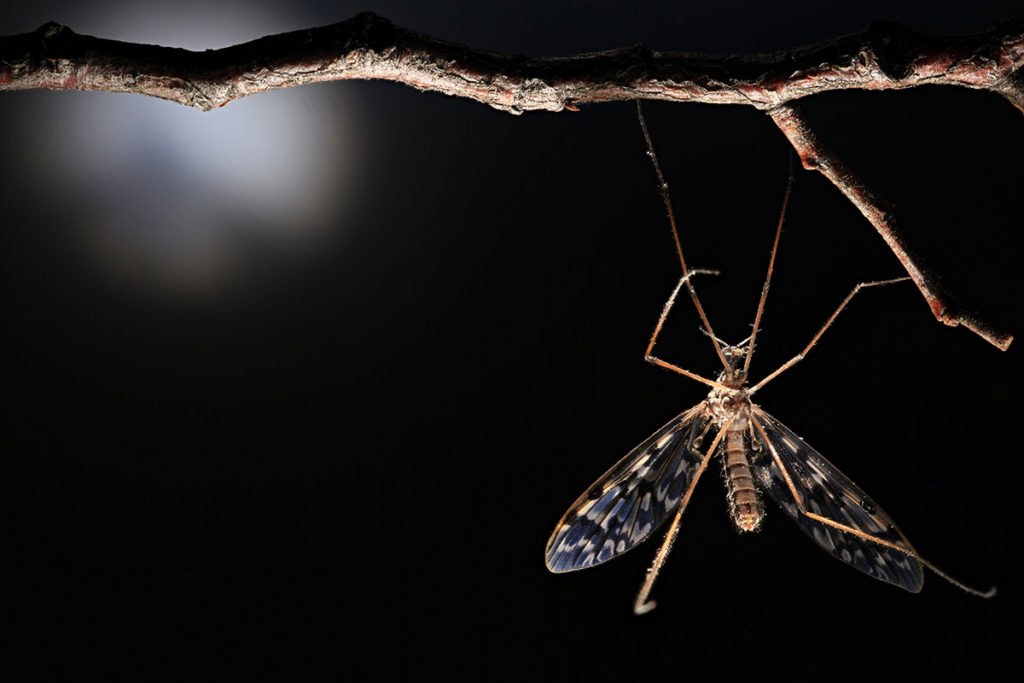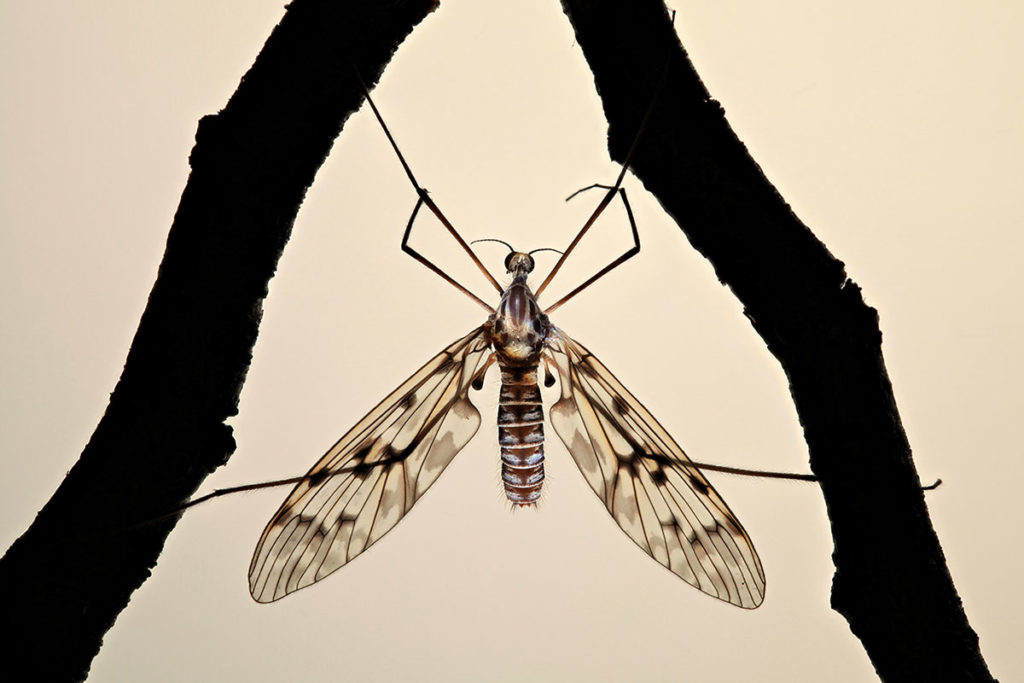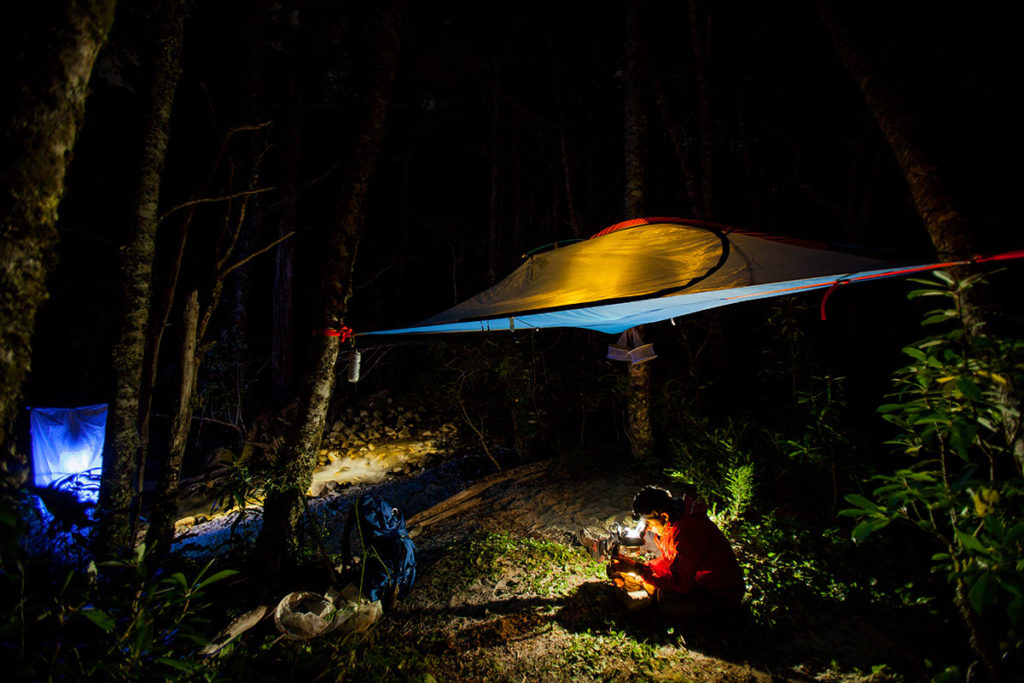While packrafting the southeastern edge of the Northern Patagonia Ice Field along Chile’s largest river, the Baker, in search of primitive crane flies, Anand Varma and I came across an exciting find.
In a fragmented location only accessible via water, among a lichened-covered forest, we discovered a single wing of the genus Neoderus adhered to the underside of a leaf, between the Northern and Southern Ice Fields. Yes, a single wing is a fantastic find when it comes to primitive crane flies.
Most likely you have never heard of them and that is because primitive crane flies are considered to be one of the rarest groups of flies in the world and only a handful of people have been able to collect them. With only one specimen ever collected in the late 1800s in the southern Chilean fjords, the genus Neoderus can be considered the rarest of all primitive crane flies.
During my last expedition in 2015 I secured four flies, the first and only specimens collected of this genus since its discovery.

With colder temperatures marking the last chance this year to find this rare group, I set off once again to complete what Anand and I started. I decided to target the locality where I found a lone wing two years prior. I loaded my backpack, took my hiking poles (or as my collaborators call them, “my gimpy sticks”, due to the frequency of my ankle injuries) and limped into one of the most pristine creeks I have seen. After a 1100ft climb and bushwhacking across dense forest I arrived to the location.
Upon arrival I removed my hiking boots and proceeded to relieve my ankle pain in the glacial creek. Soon after, I unpacked my 60+lb backpack and identified the perfect configuration for my tree tent, which was strategically located near the creek 6ft above the ground. Below my tent, I set up my “field laboratory” consisting of a stereomicroscope from the early 1980s with generic USB lights secured by duct tape and powered via rechargeable solar battery. This arrangement allows me to collect aquatic insects and immediately identify any promising specimen under high magnification. The dream camp set up of any insect-loving seven-year-old!
Not only does my tree tent provide a dry refuge from sudden rainfall, characteristic to this area, but it is also the perfect barrier from the numerous avian intestinal discharges I am constantly being bombarded with by territorial birds.
With sunset approaching, I decided to have something to eat. I packed all the necessary gear for this short expedition but managed to forget food.
Loose in one of my backpack’s hipbelt pockets, I found a handful of stale trail mix (from sometime since September) and a piece of chocolate.
Lack of aesthetically pleasing or “proper” camping food, seem to be a trend for this site. A couple of years ago, my food bag punctured and got wet while reaching this exact location, leaving me to consume lukewarm soft cheese, soggy bread and broken crackers accidentally blended into a paste-like consistency. Read more about this particular story here.
This time was no different. As I searched the creek looking for the unknown larvae of Neoderus and other aquatic insects, I intentionally separated the largest common stoneflies. I later proceeded to make my “back-country specialty” of au naturel stonefly and stale raisin kebabs on endemic southern beech twigs, complemented with all-you-can-drink glacial melts. A true delight! My other options were: 1) No food or 2) Soggy almonds and common black fly larvae, but the latter are quite slimy and a last resort among the edible insect choices on my list.
With hunger “satisfied”, I set up my blacklight a few feet away from the stream. While waiting for insects to be attracted to the light reflected on a white sheet, I set off into the dark forest in true nerd-like fashion with my rain pants synched up to my mid abdomen, my cuffs tucked into my socks and sporting my night vision goggles in search of nocturnal six-legged gems.

Throughout the night, the UV light attracted all sorts of insects, including Darwin’s beetles, half-inch-long parasitic wasps, caddisflies, moths and many midges. Alas, no Primitive Crane Flies.
Soon after midnight, rain drove away most of the insects and continued to pour until mid-morning. With sunrise approaching and a sufficient few hours of sleep, I climbed out of bed, ate a forgotten stonefly still in the “food” container and the piece of chocolate for breakfast, put on my rain gear and limped across the forest in search of the insect I came for.
After wadding through the creek for a couple of hours with no success, I decided to direct my attention to the numerous fallen trees around the forest. Interestingly, a large decaying tree still hangs 8ft high over the creek. Underneath, a Neoderus female. After squealing like a piglet for some time, I proceeded to secure the specimen. Crane flies in general are well known among taxonomists to lose or detach their legs at will. This particular female had all six legs still attached, making it the only pristine specimen in the world.
With my precious find, I headed straight back to camp. Once there, I frantically packed it all up and awkwardly limped back to my vehicle a few miles away, all the while juggling the specimen, my heavy backpack and my “gimpy sticks”.
I drove eight hours back to my headquarters and proceeded to photograph the female. After a long and continuous photography session of 48hours the female finally died, but not before yielding the photographs above. These, along with one poor quality image from 2015, are the only photographs of a live Neoderus in existence. A true reminder of the biological jewels awaiting discovery in the vicinities of the Patagonia Ice Fields.

*The Neoderus specimen in the photographs above belongs to a new species of primitive crane fly. A scientific (peer reviewed) publication is in process to formally describe this species.
